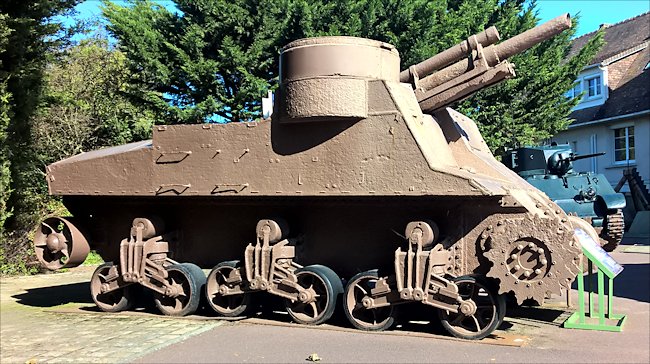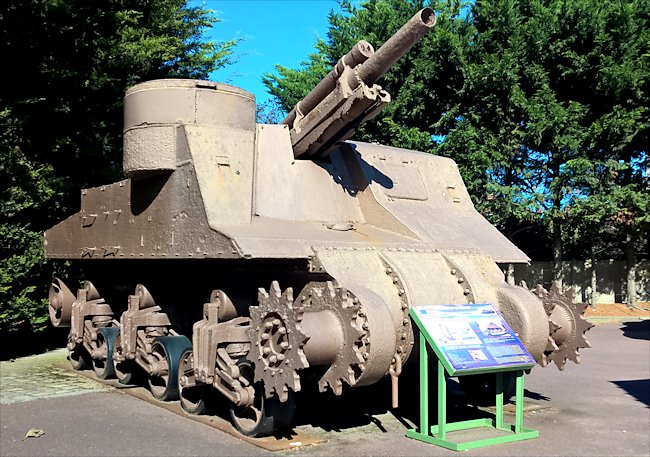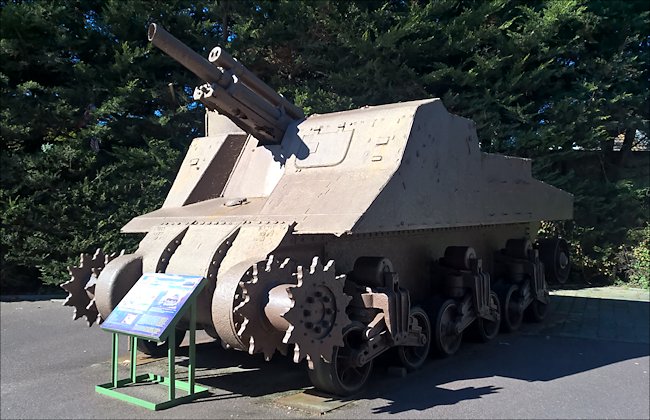Ouistreham M7 Priest SPG
Ouistreham is an attractive seaside port that became a battlefield when the Allies landed at Sword beach, Normandy on D-Day 6th June 1944. A surviving US built M7 105mm self propelled gun, nicknamed the Priest because of its pulpit like commanders tower, can be found at le Grand Bunker Museum set back from the coast.

This preserved M7 Priest Selp Propelled 105mm gun can be seen at the Le Grand Bunker Museum in Ouistreham, Normandy France.
Location
The le Grand Bunker Museum in Ouistreham is set in the middle of a residential area about 500m south of the coast. It is at the junction of the Avenue du 6 Juin with the Avenue de la Plage. When entering the address into your Sat-Nav device use the Avenue de la Plage road name.
I have found a problem with entering the number 6 in the Avenue du 6 Juin road name on different devices a problem; some want the number 6 and others want the letters six.
Specification
The original Priests used the M3 Lee tank chassis but as the M4 Sherman chassis became available production switched to using the Sherman. The US Army called it a 105mm Howitzer Motor Carriage M7. The British Army called it the 105mm Self Propelled Gun, Priest. It was built by the American Locomotive Company and Pressed Steel Car company in America between 1942 and 1945. Around 3,490 were produced.
Its armour plating ranged from 12 mm to 62 mm. It was not designed to get involved in tank combat but the armour was there to protect the crew from small arms fire and enemy mortar and artillery shrapnel counter battery fire. It was powered by a Continental R-975 C1 engine that produced 400 bhp. Its maximum road speed was 24 mph (39 km/h) and off road only 15 mph (24 km/h).

M7 Priests used M4 Sherman tank chassis. The track drive wheel has 13 teeth just like a Sheman tank's but the British Sexton SPG has 17 teeth.
Its main artillery gun was a 105mm M1/M2 Howitzer. The M7 could carry 69 rounds of high explosive HE shells. It was also fitted with one 12.7 mm M2 Browning machine gun at the top of the 'pulpit'.
The British and Commonwealth Armies in the early stages of the war used M7 Priest but because of the difficulty of obtaining American made 105mm rounds they eventually replaced their M7 Priests with Canadian built Sextons that were armed with 25pdr artillery howitzers and fired standard British shells.

The M7 Priest was used during the Battle for Normandy in 1944 to provide artillery support.
le Grand Bunker Museum
It is a small but interesting museum. Most of the large exhibits are outside, There is a well-stocked museum shop that sells D-Day related merchandise. The Bunker was built by the Germans as a control centre as part of their 'Atlantic Wall' defense system.
To the side of the bunker behind the landing craft you will find a M7 Priest and a M3A3 Stuart Light tank. On top of a wall that faced the Avenue de la Plage there is a WW1 Renault FT tank turret that was used as part of the Atlantic Wall defences.
D-Day 1944 books

